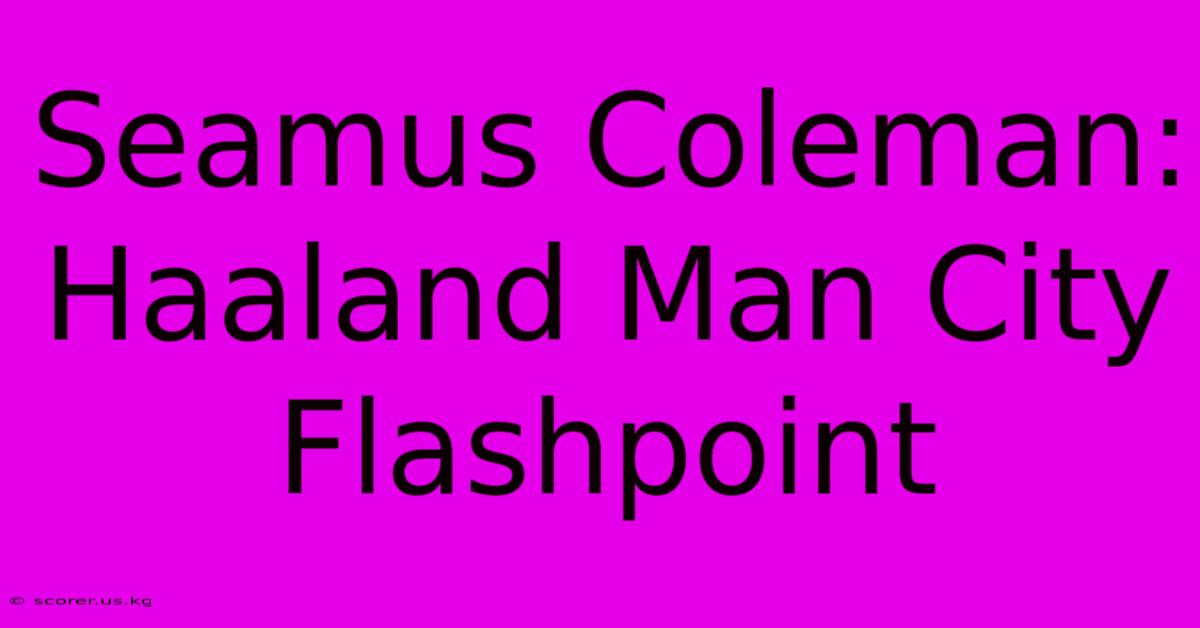Seamus Coleman: Haaland Man City Flashpoint

Discover more detailed and exciting information on our website. Click the link below to start your adventure: Visit Best Website scorer.us.kg. Don't miss out!
Table of Contents
Seamus Coleman: Haaland's Man City Flashpoint – A Deeper Dive
The Premier League is known for its intense rivalries and heated moments, and the clash between Everton's Seamus Coleman and Manchester City's Erling Haaland provided a prime example. This article delves into the incident, analyzing the context, reactions, and its wider implications for both players and teams.
The Incident: A Spark in a Tense Match
The flashpoint occurred during a fiercely contested match between Everton and Manchester City. While the exact details may vary depending on the viewing angle and individual interpretations, the core of the incident involved a physical confrontation between Coleman and Haaland. Haaland's perceived aggressive play, possibly fueled by frustration at Everton's determined defensive tactics, led to a moment of contact with Coleman. This contact, whether intentional or accidental, sparked a heated exchange between the two players. The intensity of the moment was palpable, capturing the attention of fans and pundits alike. The referee's response and any subsequent disciplinary action played a significant role in shaping public opinion.
Analyzing the Confrontation: Was it a Foul?
This is where opinions diverge significantly. Some argued that Haaland's actions warranted a card, highlighting the perceived intent and the potential danger of the contact. Others defended Haaland, suggesting the contact was minimal, unintentional, or a natural consequence of the physical nature of the game. Analyzing the incident frame-by-frame reveals subtle nuances that further complicate the debate. Ultimately, the referee's judgment is paramount and, in this case, determined whether the incident was worthy of a card, leading to much post-match discussion and analysis.
The differing perspectives also highlight the importance of considering the context of the game. Everton were battling to avoid relegation, adding an extra layer of intensity to their performance. Manchester City, aiming for the title, were applying unrelenting pressure. This high-pressure environment likely contributed to the heightened emotions on display.
Aftermath and Reactions: A Media Frenzy
The incident quickly became a major talking point in the footballing world. Social media erupted, with fans and pundits offering their opinions and analyses. The debate spilled over into post-match interviews and news outlets, generating a significant media frenzy.
Some commentators praised Coleman's resilience and fighting spirit, emphasizing his veteran presence and leadership on the pitch. Others questioned Haaland's temperament, focusing on his past incidents and potential for reckless behavior. The differing viewpoints underscore the passionate and often divided nature of football fandom.
Impact on the Game and Players
Beyond the immediate aftermath, the incident likely had a lasting impact. The confrontation, regardless of whether it was considered a foul, significantly altered the dynamics of the game. It could have influenced the players' subsequent actions and the overall flow of the match. For Haaland, it added another layer to his narrative as a young, exceptionally talented player navigating the challenges of top-level professional football. For Coleman, a long-standing Evertonian, the incident demonstrated his commitment and unwavering passion for the game.
The long-term implications could include changes in playing styles or even influencing future referee decisions in similar situations. The incident also serves as a discussion point regarding player conduct and the pressures faced by players at the highest level.
Conclusion: A Defining Moment?
The Seamus Coleman – Erling Haaland flashpoint remains a significant moment in the Premier League season. It highlights the physicality, intensity, and often controversial nature of professional football. While it may not be a defining moment in the careers of either player, it serves as a case study of how a fleeting moment on the pitch can ignite a significant debate, generate substantial media coverage, and ultimately impact the narrative surrounding both players and their respective teams. Further analysis is needed to fully understand the long-term implications, both for the players and for the wider perception of sportsmanship in professional football.

Thank you for visiting our website wich cover about Seamus Coleman: Haaland Man City Flashpoint. We hope the information provided has been useful to you. Feel free to contact us if you have any questions or need further assistance. See you next time and dont miss to bookmark.
Featured Posts
-
Premier League Analysis Liverpools Victory Man Utds Woes
Dec 27, 2024
-
K State Rallies Johnson Edwards Deliver
Dec 27, 2024
-
Boxing Day Long Waits Moderate Sales
Dec 27, 2024
-
Teddy Bridgewater Back With Lions
Dec 27, 2024
-
Geno Smiths 15 Yard Pass To Lockett
Dec 27, 2024
